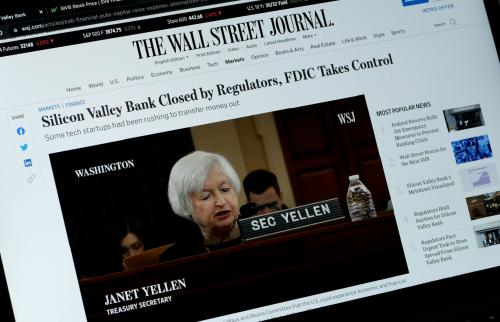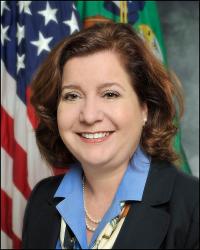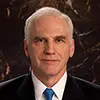The failure of three mid-sized banks in March 2023—three of the four largest bank failures in history—shook financial markets and could’ve spread to other banks if regulators hadn’t stepped in. Two on-going trends in finance contributed to these failures: an increase in uninsured deposits and the migration of business lending to non-banks. In a new paper, “The evolution of banking in the 21st century,” a group of Harvard researchers looked at regulations that could mitigate risks going forward as well as the potential implications for mergers and acquisitions among mid-sized banks. David Wessel, director of the Hutchins Center on Fiscal and Monetary Policy, hears from two of the authors, Samuel Hanson and Daniel Tarullo, on their findings in this episode of the Brookings Podcast on Economic Activity.
- Listen to the Brookings Podcast on Economic Activity on Apple, Spotify, or wherever you like to get podcasts.
- Learn about other Brookings podcasts from the Brookings Podcast Network.
- Sign up for the podcasts newsletter for occasional updates on featured episodes and new shows.
- Send feedback email to [email protected].
Transcript
[music]
EBERLY: I am Jan Eberly, the James R. And Helen D. Russell Professor of Finance at Northwestern University.
STEINSSON: And I’m Jón Steinsson, Chancellor’s Professor of Economics at the University of California, Berkeley.
EBERLY: We’re the coeditors of the Brookings Papers on Economic Activity, a semiannual academic conference and journal that pairs rigorous research and real time policy analysis to address the most urgent economic challenges of the day.
STEINSSON: And this is the Brookings Podcast on Economic Activity, where we share conversations with leading economists on the research they do and how it will affect economic policy.
Three of the four largest ever bank failures occurred over just the few days in March 2023. Today’s discussion focuses on two trends of recent decades that made the banks that failed and others like them more vulnerable. The paper is titled “The Evolution of Banking in the 21st Century: Evidence and Regulatory Implications,” and was authored by Samuel Hanson, Victoria Ivashina, Laura Nicolae, Jeremy Stein, Adi Sunderam, and Daniel Tarullo, all of Harvard University. Sam and Dan will be joined in this conversation by David Wessel, director of the Brookings Hutchins Center on Fiscal and Monetary Policy.
EBERLY: The bank failures of a year ago prompted a debate about how to make our financial system safer and less prone to the stresses that often require government intervention and support. The Dodd-Frank act, after the global financial crisis, was intended to strengthen institutions and reduce the likelihood of failures and interventions. Much of the discussion has focused on the features of this and subsequent legislation. These authors point out that the banking system has changed as well, in ways that may make deposits less stable and bring in fewer loans. Not exactly the banking system we used to know. These authors ask how regulatory changes should take these structural shifts into account.
STEINSSON: The authors are really going after what I think of as a core issue when it comes to how to think about the value banks provide in society and how best to regulate them. Namely, do banks provide value mainly by making loans? So, that’s an asset side view of the value of banks. Or do they mainly provide value by offering demand deposits—a liability side view. The truth is surely somewhere in between, but it seems to be shifting towards the liability side view. This is really interesting and it’s likely to have important implications for regulatory policy.
EBERLY: So, let’s pass it off to David to hear more.
WESSEL: Thanks, Jan and Jón, and welcome to this podcast, Dan Tarullo.
TARULLO: Thanks very much, David. Good to be with you.
WESSEL: And nice to see you, Sam.
HANSON: Good to see you too, David.
[3:13]
WESSEL: So, Dan, maybe you could start by explaining what led this impressive bunch of Harvard professors to get together and start chewing over what was going on in the banking business these days.
TARULLO: Well, David, it was essentially prompted by the failures of Silicon Valley Signature and First Republic banks back in the spring of 2023. The group of us, the six authors, like I think a lot of groups around the country, just got together to talk amongst ourselves about what we thought had happened and what might be an appropriate regulatory response. But after just a couple of conversations, I think we all felt that there was utility in digging more deeply into what had been going on in the banking industry generally.
And as you know from the final paper, what was essentially done is to use those empirical findings to help shape our policy recommendations.
[4:06]
WESSEL: So, Sam, banks do two things. They take deposits and they make loans and buy securities. So, can you talk a little bit about what you observed on both sides of the bank balance sheet?
HANSON: Yes. So, you said it very well. We think of the two fundamental pillars of banking and their reasons for being as first deposit taking—think of that as offering either safe savings products or transaction services, allowing us to transact in the economy. And on the asset side, their key role is lending, in particular making loans to difficult to monitor borrowers, people who might be difficult to understand, the small business, who can’t just obviously go out and float their bonds on the securities market.
In terms of the broad trends, on the lending side—and this has been ongoing for decades, but certainly has continued this century—we’ve just sort of seen a steady growth in lending by non-bank institutions and steady growth of securities market in the declining overall importance of lending by banks to these opaque sorts of borrowers. On the asset side, what banks used to do is just becoming a smaller part both of their own business and probably a less vital source of credit for the economy as a whole.
However, on the liability side, the deposit taking business, I think seems to be as important as ever. So, you know, specifically, deposits have been rising a lot relative to this overall size of the economy relative to gross domestic product. That’s mainly because deposits have actually been relatively stable relative to wealth. Roughly speaking, households tend to put about 15% of their total wealth into savings type products. But wealth has been growing a lot relative to GDP, as we know this century.
And moreover, a growing share of bank deposits are becoming uninsured. Since 1995, about 20% of bank deposits were uninsured. Today it’s risen to be 40%. So, the sort of caricature—
WESSEL: —Let me stop you there, they’re uninsured because people have put more money into the bank than the $250,000 ceiling?
HANSON: Exactly.
WESSEL: And that was a big problem at Silicon Valley Bank, they had an unusually large amount of uninsured deposits?
HANSON: Exactly. So, yeah, these are either deposits of higher net worth individuals, and many of them are deposits of firms or large institutions that are just going to be above that $250,000 insurance limit. So, yeah, the kind of caricature of the direction in which the banking industry is evolving is they still take deposits as ever, but they increasingly invest them in securities, in long term securities, where unlike loans they don’t really have this special edge. So, they’re becoming a little bit more like deposit-financed bond funds.
[6:57]
WESSEL: I see. So, Dan, what are the problems with having a banking system that has a lot of uninsured deposits? Why should we worry about that?
TARULLO: Well, in the first instance, as we saw rather graphically in March of 2023, when depositors know that their deposits are not protected by the FDIC, if they get a whiff of trouble in a bank, their very rational instinct is going to be to pull those funds from the bank. And of course, banking by its nature is an effort to transform the maturities of different kinds of obligations. So, conventionally banks make loans that take time to pay off, but they take deposits, many of which can be demanded immediately. And so, if too many depositors are demanding their deposits back, the bank is not going to have the kind of funds available to pay them. And in the worst case, that will lead the bank to start selling at fire sale prices some of its assets, like the loans that it’s made.
And, you know, we’ve seen this in different forms throughout the history of banking. We saw before the Depression the runs on banks in a different kind of form. In 2007 and 2008, we saw runs on the repo market. What we saw last spring was a more classic bank run. But of course, it was concentrated in the uninsured deposits.
[8:22]
WESSEL: Right. And it wasn’t just Silicon Valley Bank. The reason it was so unsettling was these things tend to spread. Everybody says my uninsured deposits aren’t safe.
TARULLO: Correct. What essentially happens, David, is that depositors or investors look at other banks and say, are these other banks enough like the one that’s undergoing the run right now, that I want to get out first and ask questions later? and that happened to Signature within 24 hours and to First Republic within a month, and could well have happened to other banks had the government not intervened to take the measures it did to prop up the system.
[9:00]
WESSEL: So, Sam, if banks are in the business of taking deposits and making loans, why are banks putting more and more of their money into securities rather than making loans? What’s driving them to do that?
HANSON: I think at a high level, our view is in some sense that banks are deposit rich, so they still have plenty of deposit funding because households, firms still want to use deposits as a safe store of value. So, there’s plenty of demand for banks’ liabilities. People want to invest in banks.
But banks increasingly don’t have as many great lending opportunities. And a lot of that is just because of the inroads that various kinds of non-bank lenders have made over the past several decades. So, for instance, in terms of business lending, 30 or 40 years ago, essentially the only way that a business could get a loan was to go to a group of banks. Over the past 30 or so years, there’s been a development of a very large, syndicated lending market in which other financial institutions, such as pension funds, insurance companies, mutual funds now also make loans to firms.
And in more recent years have been some pretty significant inroads in terms of what people would call the private credit market. These are non-bank institutions that lend to small to mid-sized firms. And this has actually been quite a rapid growth area of non-bank credit. So, some of this is just banks’ bread and butter in terms of lending. They’re just facing steady competition from non-bank financial institutions.
[10:39]
WESSEL: So, Dan as you know, that’s undoubtedly true and the banks point that out at every opportunity. But they also say that regulations that you and your successors in the Federal Reserve and other bank regulatory agencies have made it harder for them to make loans, and that’s forcing borrowers to these other avenues which don’t have the same capital requirements and such. Is there anything to that argument?
TARULLO: Oh, sure, there’s something to it. But there are several important considerations here, David. One, precisely because banks are still the backbone of the payment system, and banks are still an important mechanism for transmitting monetary policy, assuring the stability of the banking system is still a very high priority. So, you can’t simply say, well, gee, if the banks are getting some competition from elsewhere, we need to deregulate them so that they can make more money if the result is going to be an unstable banking system.
Now, the second consideration is, though, if there are systemic risks being created outside the banking system by some of these non-bank actors to which Sam referred, then it’s incumbent upon the government to figure out appropriate regulation to contain those systemic risks. Back in the late 1980s, when bankers were making the point that they were coming under competition from public debt markets, for example, the response of the government over a 30-year period was basically to deregulate the banks, and that culminated in the 2007-2008 crisis. A better response now, I think, would be to think carefully about your bank regulation, but also to take actions to make sure that you’re not having a migration of systemic risk elsewhere.
The third factor to take into account is that the phenomenon Sam described a few moments ago is most acute, I think, in what we would term the mid-sized regional banks. The very big banks like Bank of America and JP Morgan, essentially, they have achieved enormous economies of scale, and thus they are increasingly able to dominate a number of areas of bank lending. On the other end of the spectrum, community banks, those in that $30, $20, $10 billion range and smaller are able still to engage in true relationship banking, where you get beyond the numbers and they really get to know their borrowers.
But that space in between, a space occupied, by the way, by all three of those banks that failed last spring, the space in between is becoming an increasingly difficult place to inhabit, and that probably has something to do with the findings that Sam just told you about. They don’t have the lending opportunities, and thus they’re putting the deposits into securities, basically.
[13:41]
WESSEL: All right. So, let’s turn to what we should do about this. Sam, let me start with you. So, we see this unhealthy situation where banks have a lot of uninsured deposits. The deposits that are uninsured can run. When that happens to a great extent, that forces the government to step in. And many of the banks that you describe in your paper are investing these uninsured deposits in securities, U.S. Treasury bills, not lending him to mom-and-pop businesses. So, that doesn’t seem like a great situation.
We’ll talk about mergers in a minute, but can you talk a little bit about what do you recommend we do about reducing the risk of this kind of situation? What should we ask the banks to do in terms of managing their liquidities? Or maybe the government should discourage all these uninsured deposits.
HANSON: Yeah. So, I think last spring really showcased how vulnerable this system can be to widespread and very rapid runs by uninsured depositors. I think at a high level, there’s two broad categories of options for dealing with this problem. The first would be to basically expand the level of deposit insurance coverage. So, as you referred to earlier, today a given individual or their institution or a given firm, if they place deposits in a given bank, the first $250,000 are insured by the FDIC. Everything above the insurance limit is uninsured. So, a first possibility would be just increase that insurance limit. Increase it significantly perhaps.
So the concerns there would be that the government is never going to perfectly price that insurance that they’re offering to depositors. And as a result, you might worry that a significant expansion in deposit insurance coverage would worsen what people would call the moral hazard and distortions, expose taxpayers to losses. So, either the banks would be taking gambles that don’t make sense because they’re not being priced in the insurance. Or alternately, once banks get in trouble, sometimes we think that the fact that depositors actually do have the right to vote with their feet and to run plays an important role in making sure that bad failing banks like an SVB get shut down. So, expanding deposit insurance would certainly get rid of the run problem, but I don’t think anyone thinks that that’s cost free from a social perspective.
The alternate approach that you could take would be to tighten what we would call liquidity regulation. So, basically for a long time and these were reinvigorated following the global financial crisis and Dodd-Frank, we often have asked banks to hold some amount of liquid assets to back any runnable deposits, deposits that can be withdrawn on demand. So, the proposal that we sketched out in our paper would be to use an existing set of these liquidity-like requirements, something called the liquidity coverage ratio. And basically, asked banks to back a very significant fraction of their uninsured deposits by holding liquid securities, predominantly short-term securities, that they could be used on demand to meet those withdrawals.
This also doesn’t come for free, as you just alluded to. If banks are now holding these liquid securities and they’re not making loans to mom and pop, by asking banks to self-insure against this run by holding liquid assets, we’re foregoing some good potential lending opportunities. And this is where our reading overall of the industry trends comes in. Our sense that banks are playing a kind of declining role in lending, providing very special loans that people cannot get outside the banking system, suggests that the costs of this forgoing loans, if we ask banks to self-insure and hold a lot of liquid assets, but they’re smaller than they might have been, say, 40, 50 years ago, and therefore that that would incline us towards dealing with this run problem by tightening liquidity regulation as opposed to primarily doing it by expanding deposit insurance.
[17:41]
WESSEL: So, as I understand it, what you’re basically saying is if you’re a bank and you want to have a lot of uninsured deposits, you’re going to have to buy a lot of short-term Treasury bills and set them aside. Things that can be sold quickly. And the banks may not like this because you don’t get much return on a short-term Treasury bill. So, if what happens is they say, well, then we’ll have fewer uninsured deposits. Well, that’s kind of what you want to happen. And if the banks were making a lot of loans, you’d worry then they’ll make fewer loans. But given that so much of the money is going into securities anyways, the social cost of essentially shrinking these banks’ balance sheets a little bit would not be that great. It wouldn’t be that much less lending.
HANSON: Exactly. Essentially, this money could flow outside of the banking system, and non-bank institutions could be holding these securities that banks are currently holding. We think that that would be, while not zero cost, would probably be much better than the status quo or than a massive expansion in deposit insurance.
[18:41]
WESSEL: So, Dan, you kind of tiptoed up to this issue earlier. As you know, there seems to be a great deal of hostility to mergers in general in Washington these days, bank mergers included. So, what is your conclusion on bank mergers, Dan? I know that you don’t think that we need to get JP Morgan and Bank of America any bigger. They’re plenty big. The question is, which kind of bank mergers do you think would be good for the system, create competition, make the system more stable, and make it better for borrowers and depositors?
TARULLO: My evolving views on bank mergers have only been reinforced by the empirical work we did in this paper.
WESSEL: Well, that’s refreshing.
TARULLO: Yeah, and it didn’t start out to try to prove it either. It was literally one day during one of our meetings, Jeremy looked at me and said, we should fold in your merger discussion because we’re getting some findings that suggest the power of that.
So, as I indicated earlier, I think the regional banks, the roughly $50, $60 billion to a couple hundred-billion-dollar banks have been and continue to be in a business strategy squeeze or business model squeeze. What the empirical work here did was to show, I think, the degree to which they are relying on their deposit franchise, but doing so, as Sam indicated, by acting as a form of medium-term bond fund. And there, they’re no longer engaged in the classic maturity transformation for information intensive loans that we rely on the commercial banking system to engage in.
So, it’s that group of banks that I’m concerned are, over time, going to be increasingly squeezed. And as a result of which one of a couple of things can happen. One, they start taking a lot more risks and then can recreate last spring, where a bank with a less than sound business model gets into trouble. And this contagion to other banks that may appear to depositors to be similarly situated.
The second thing that may happen is they just start to atrophy. They can’t get the business. Where is that business going to go? I think there’s a pretty good shot that a high percentage of the business ends up going to the banks that are already very big. So, contrary to what I know competition advocates would want, not letting some of these mid-sized banks consolidate—consolidate in a space where there’s going to need to be consolidation—not letting them consolidate may end up paradoxically increasing concentration at the high end of the market.
So, our observation—we didn’t try to give a detailed antitrust analysis—but our observation was that our findings reinforce at least what some of us had as a prior, which is that it would be good for the Antitrust Division and the banking authorities to think in more dynamic terms when mergers involving banks in this space come before them. It doesn’t mean they should approve every one, but that they should look beyond the short-term effects in one or more markets to think about how the banking industry is evolving and how we’re going to have effective competition in the industry over the next decade.
[22:07]
WESSEL: So, the vision you sketched out, I imagine, is we’re going to have some really big banks. We have big banks. They probably have a role dealing with big global multinationals, all that. And you’d like to see a second tier of muscular banks that can compete with them. And that’s what these mergers would create.
TARULLO: And that at least can create the scale that gives them a shot at it. I mean, I think, you know, right now we have PNC and U.S. Bank and Capital One, and really TD Bank as well, which they’re not up there in the Bank of America, Citi JP Morgan category. But they’re big. They’re $4 or $5, $600 billion of assets. I think it’s at least possible that a better position for savers and borrowers in the U.S. Economy would be to have eight banks of that size that are effectively competing nationally. I don’t think people are going to be enthusiastic about seeing more $2 trillion banks, but more banks of three quarters of a trillion dollars of assets that are basically commercial banks that don’t have a lot of trading operations.
That’s at least something, again, which I think the bank regulators and the Antitrust Division should think about as a possible better outcome for competition in the country.
[23:29]
WESSEL: And Sam, is there anything that you think we should touch on that I haven’t asked you about that you want to throw in here?
HANSON: On the bank merger and consolidation piece I think the other thing that I would point to is. From a regulatory supervision standpoint, I would be much more comfortable with a system where we, exactly as Dan said, I don’t know, we have eight, say, $500 billion banks, and we’re going to actually spend some serious effort in making sure that we’re regulating them and actually watching them carefully, to one where there’s 50 $100 billion banks that no one’s really monitoring all that closely. And that’s essentially the situation that we had with Silicon Valley Bank.
The analogy that I’ve sometimes drawn is, and this is just sort of almost a social risk management perspective, if we were running a nuclear industry and I told you that we had hundreds of nuclear firms that each operated a singular nuclear plant that were all engaged in dealing with the Energy Department, you would think that that was probably pretty crazy because, you know, if one of these has an accident, it’s a problem not just for them, but it’s a problem for the entire industry. And I think the banking industry is pretty analogous to them. So, I think from a risk management perspective, it makes quite a good deal of sense.
And the other thing is in terms of from a market power standpoint, I think consumer protections, things that the CFPB can do, play a much more important role than whether there’s five banks or four banks in my metropolitan area in terms of achieving competitive outcomes.
WESSEL: I’m not sure the banking industry will appreciate being likened to the nuclear power industry, given how well that’s done lately, but I always appreciate a good metaphor.
[music]
So, thank you for that, Sam, and thank you, Dan, for your time on this really interesting and important paper.
TARULLO: Okay. Good to be here, David.
HANSON: Thank you.
STEINSSON: Once again, I’m Jón Steinsson.
EBERLY: And I’m Jan Eberly.
STEINSSON: And this has been the Brookings Podcast on Economic Activity. Thank you to our guests for this great conversation and be sure to subscribe to get notifications about new releases of this podcast.
EBERLY: The Brookings Podcast on Economic Activity is produced by the Brookings Podcast Network. Learn more about this and our other podcasts at Brookings dot edu slash podcasts. Send feedback to Podcasts at Brookings dot edu and find out more about the Brookings Papers on Economic Activity online at Brookings dot edu slash BPEA.
STEINSSON: Thanks to the team that makes this podcast possible, including Kuwilileni Hauwanga, supervising producer; Fred Dews, producer; Gastón Reboredo, audio engineer; with support from Shannon Meraw and Chris Miller in Economic Studies at Brookings. Show art was designed by Katie Merris at Brookings and promotional support comes from our colleagues in Brookings Communications.









Commentary
PodcastWhat should regulators do about the risks to mid-sized banks?
June 6, 2024